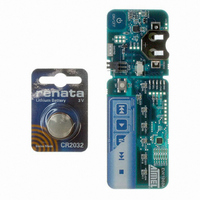EVK1060A Atmel, EVK1060A Datasheet - Page 7

EVK1060A
Manufacturer Part Number
EVK1060A
Description
KIT EVAL FOR AT42QT1060-MMU
Manufacturer
Atmel
Series
Quantum, QTouch™r
Specifications of EVK1060A
Sensor Type
Touch, Capacitive
Sensing Range
1 Button/Key
Interface
I²C
Sensitivity
2mm ~ 5mm Pad Widths
Voltage - Supply
3V
Embedded
No
Utilized Ic / Part
AT42QT1060
Silicon Manufacturer
Atmel
Silicon Core Number
AT42QT1060-MMU
Kit Application Type
Sensing - Touch / Proximity
Application Sub Type
Capacitive Touch
Silicon Family Name
QT1060
Rohs Compliant
Yes
Lead Free Status / RoHS Status
Lead free / RoHS Compliant
2.7
2.8
2.8.1
2.8.2
9505E–AT42–02/09
Change Line
Types of Reset
External Reset
Soft Reset
There can be one AKS group, implemented so that only one key in the group may be reported
as being touched at any one time. A key with a higher delta signal dominates and pushes a key
with a smaller delta out of detect. This allows a user to slide a finger across multiple keys with
only the dominant key reporting touch.
The keys which are members of the AKS group can be set via the AKS mask (see
on page
For maximum flexibility there is no automatic key recalibration timeout on key detection. The
user should issue a recalibration command if the key has been in detect for too long, for
example for more than 30 seconds (see
The Change line (see CHG in
the Detection or Input status bytes and is active low. It is cleared (allowed to float high) when the
host reads the status bytes.
If the status bytes change back to their original state before the host has read the status bytes
(for example, a touch followed by a release), the CHG line will be held low. In this case, a read to
any memory location will clear the CHG line.
The CHG line is open-drain and should be connected via a 100k resistor to Vdd. It is
necessary for minimum power operation as it ensures that the QT1060 can sleep for as long as
possible. Communications wake up the QT1060 from sleep causing a higher power
consumption if the part is randomly polled.
The keys enabled by the key bit mask or a change in the Input port status cause a key change
interrupt (see
mask and including it in the AKS mask. Touching the guard channel does not cause an interrupt.
The key and AKS masks are set by using the mask commands (see
An external reset logic line can be used if desired, fed into the RST pin. However, under most
conditions it is acceptable to tie RST to Vdd.
The host can cause a device reset by writing a nonzero value to the reset byte. This soft reset
triggers the internal watchdog timer on a ~16 ms interval.
The device NACKs any attempts to communicate with it during the first 30 ms of its initialization
period.
After CHG goes low, the device calibrates the sensing channels. When complete, the CHG pin is
set low once again.
• After ~16 ms the device resets and wakes again.
• After a further 30 ms initialization period the device begins responding to its I
• After another ~80 ms the device asserts the CHG line to indicate it is ready for touch sensing.
slave address.
22). Keys outside the group may be in detect simultaneously.
Table 6-1 on page
Figure 1-1 on page
17). Create a guard channel by removing that key from the key
Figure
2.9).
4) signals when there is a change in state in
Table 6-1 on page
AT42QT1060
2
C-compatible
Section 6.15
17).
7












